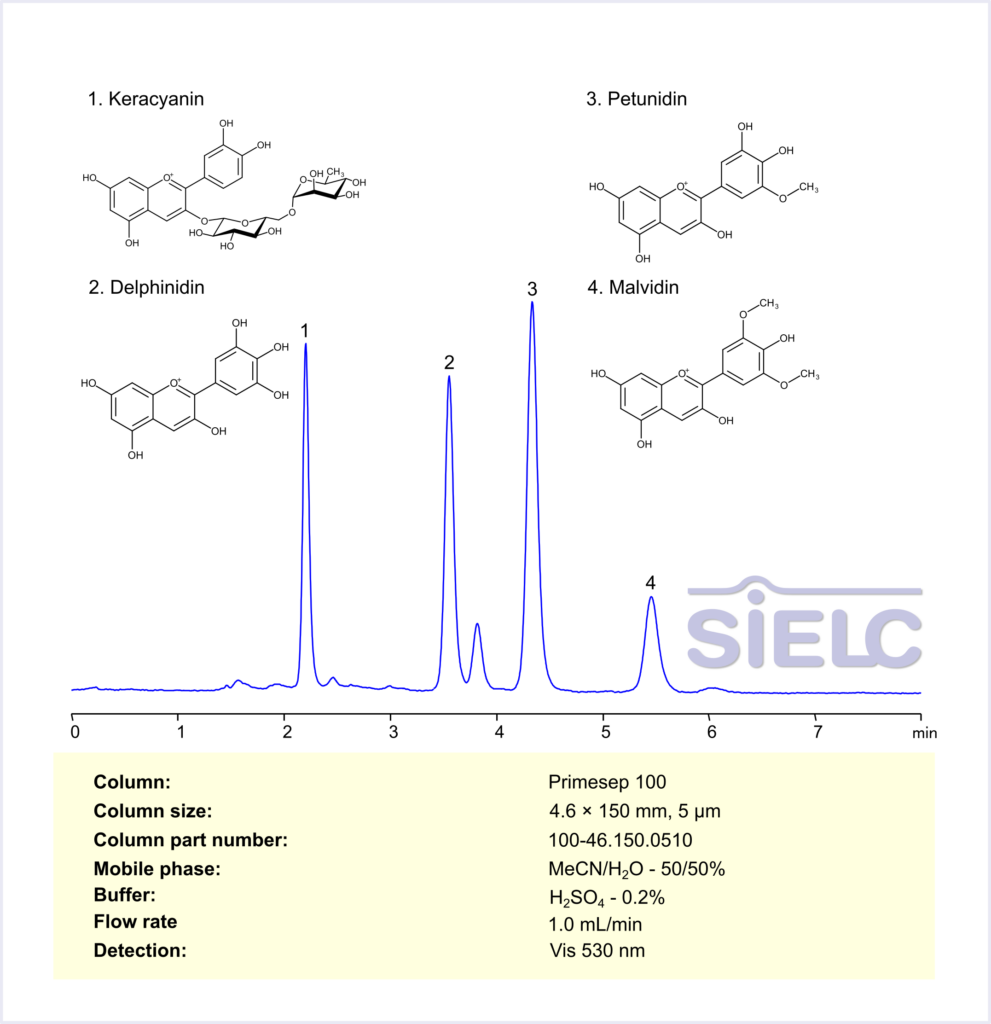| CAS Number | 13270-60-5 |
|---|---|
| Molecular Formula | C16H13O7+ |
| Molecular Weight | 317.27 |
| InChI Key | AFOLOMGWVXKIQL-UHFFFAOYSA-O |
| Synonyms |
|
Applications:
HPLC Method for Analysis of Anthocyanins (Keracyanin, Delphinidin, Petunidin, Malvidin) on Primesep 100 Column
September 19, 2024
High Performance Liquid Chromatography (HPLC) Method for Analysis of Anthocyanins (Keracyanin, Delphinidin, Petunidin, Malvidin) on Primesep 100 by SIELC Technologies
Separation type: Liquid Chromatography Mixed-mode SIELC Technologies
High Performance Liquid Chromatography (HPLC) Method for Analysis of Keracyanin, Delphinidin, Petunidin, Malvidin
Anthocyanins are a class of water-soluble pigments responsible for the red, purple, and blue colors found in many fruits, vegetables, and flowers. They belong to the flavonoid group of phytochemicals and have strong antioxidant properties.
Anthocyanins (Keracyanin, Delphinidin, Petunidin, Malvidin) can be retained, separated and analyzed using a Primesep 100 mixed-mode stationary phase column. The analysis employs an isocratic method with a simple mobile phase comprising water, acetonitrile (MeCN), and sulfuric acid as a buffer. This method allows for detection using Vis 530 nm.
You can find detailed UV-Vis spectra of Keracyanin, Delphinidin, Petunidin, Malvidin and information about its various lambda maxima by visiting the following links: Anthocyanins (Keracyanin, Delphinidin, Petunidin, Malvidin)
| Column | Primesep 100, 4.6 x 150 mm, 5 µm, 100 A, dual ended |
| Mobile Phase | MeCN – 50% |
| Buffer | H2SO4 – 0.2% |
| Flow Rate | 1.0 ml/min |
| Detection | Vis 530 nm |
| Class of Compounds | Anthocyanins |
| Analyzing Compounds | Keracyanin, Delphinidin, Petunidin, Malvidin |
Application Column
Primesep 100
Column Diameter: 4.6 mm
Column Length: 150 mm
Particle Size: 5 µm
Pore Size: 100 A
Column options: dual ended
Keracyanin
Malvidin
Petunidin

UV-Vis Spectrum of Petunidin
September 18, 2024
If you are looking for optimized HPLC method to analyze Petunidin check our HPLC Applications library
For optimal results in HPLC analysis, it is recommended to measure absorbance at a wavelength that matches the absorption maximum of the compound(s) being analyzed. The UV spectrum shown can assist in selecting an appropriate wavelength for your analysis. Please note that certain mobile phases and buffers may block wavelengths below 230 nm, rendering absorbance measurement at these wavelengths ineffective. If detection below 230 nm is required, it is recommended to use acetonitrile and water as low UV-transparent mobile phases, with phosphoric acid and its salts, sulfuric acid, and TFA as buffers.
For some compounds, the UV-Vis Spectrum is affected by the pH of the mobile phase. The spectra presented here are measured with an acidic mobile phase that has a pH of 3 or lower.



